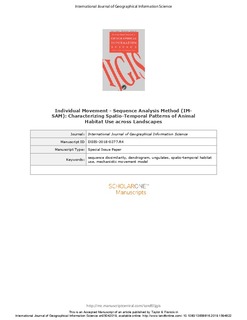Individual Movement - Sequence Analysis Method (IM-SAM): characterizing spatio-temporal patterns of animal habitat use across landscapes
De Groeve, Johannes; Cagnacci, Francesca; Ranc, Nathan; Bonnot, Nadège C.; Gehr, Benedikt; Heurich, Marco; Hewison, A.J. Mark; Kroeschel, Max; Linnell, John Durrus; Morellet, Nicolas; Mysterud, Atle; SAndfort, Robin; Van De Weghe, Nico
Peer reviewed, Journal article
Accepted version

Åpne
Permanent lenke
http://hdl.handle.net/11250/2642866Utgivelsesdato
2019Metadata
Vis full innførselSamlinger
- Scientific publications [1392]
Originalversjon
10.1080/13658816.2019.1594822Sammendrag
We present methodological advances to a recently developed framework to study sequential habitat use by animals using a visually-explicit and tree-based Sequence Analysis Method (SAM), derived from molecular biology and more recently used in time geography. Habitat use sequences are expressed as annotations obtained by intersecting GPS movement trajectories with environmental layers. Here, we develop IM-SAM, where we use the individual reference area of use as the reference spatial context. To assess IM-SAM’s applicability, we investigated the sequential use of open and closed habitats across multiple European roe deer populations ranging in landscapes with contrasting structure. Starting from simulated sequences based on a mechanistic movement model, we found that different sequential patterns of habitat use were distinguished as separate, robust clusters, with less variable cluster size when habitats were present in equal proportions within the individual reference area of use. Application on real roe deer sequences showed that our approach effectively captured variation in spatio-temporal patterns of sequential habitat use, and provided evidence for important behavioral processes, such as day-night habitat alternation. By characterizing sequential habitat use patterns of animals, we may better evaluate the temporal trade-offs in animal habitat use and how they are affected by changes in landscapes